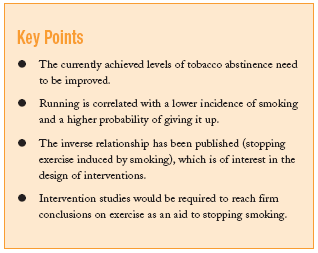The tobacco habit is one of the biggest public health problems in our country. To smoke is a significant risk factor of cardiovascular diseases, cancer and hypertension, and one of the principal causes of premature death in the industrialised countries. Stopping smoking prolongs life and reduces morbility.1
Many attempts to stop smoking are made without help, but only 2%-4% of cases continue after 12 months of abstinence. The attempts without help, particularly by using a combination of behavioural orientation and nicotine replacement therapy (NRT), or with bupropion, can improve the success rate, but these remain low1 and are, for example, 14%-20% with NTR depending on its form.2
The use of physical exercise as an additional aid to stopping smoking is very attractive, since physical exercise also reduces the cardiovascular risk.3 The article commented on evaluates the influence of running on continuing the tobacco habit using cases-controls methodology. The choice of running is very appropriate, from a cardiovascular point of view, as it is a vigorous aerobic exercise (except for the absence of fast running, absent in the sample, given that the minimum duration was 45 minutes), and is the type of exercise that is more clearly associated with cardiovascular protection.3
The results of the article clearly show that runners are less likely to smoke (8.4% current smokers among runners as opposed to 41.7% among controls) and that they are more likely to give up the habit in both cases (45.8 as opposed to 31.2%), with highly significant differences.
The present study has limitations due to its observational case-control methodology, despite the correct choice of controls, and it is hoped that the confounding factors have been balanced where possible. In particular, it is the possibility, indicated by the authors in the Discussion section, that the concern for health leads, on the one hand to running and, on the other, to stop smoking. This limitation is inevitable in a case-control study and even in an intervention study it would not be completely free from it. Running requires the voluntary intervention of the patient, therefore, the subjects who are less concerned about health could withdraw from the programme due to the effort required, and it is expected that these less motivated subjects were also more inclined to keep on smoking or fall back into the habit.
As a potentially important detail for effort activities in sport and the cessation of smoking in daily practice and for future investigations, the opposite effect to that described in this article can also be produced, since a correlation has been shown between smoking and giving up sport, at least in adolescents.4 This finding serves as a reminder of the frequent association of healthy conduct with the unquestionable interest to design interventions (the more factors the better) and for the interpretation of observational results (care with multiple associations of favourable and unfavourable lifestyle factors).
In future studies, attention should be paid to several points. On the one hand, it would be advisable to evaluate the effect of other types of exercise, particularly aerobics. Differences in the frequencies of smoking habits have been found in Norwegian adolescents not only depending on the level of physical activity and sport activity, but also on the sport activity carried out.4 The frequency of the exercise was inversely related to that of smoking, but the participants in sports which require less effort, particularly bodybuilding and fighting sports, smoke more per day than those who do not participate in sports. Given that interventions on habits need the active and prolonged cooperation of the patient, to be able to offer a wider range of possible types of exercise would help in the success of these programmes.4
Intervention studies would need to be carried out to arrive at a firm conclusions on exercise as an aid to tobacco abstinence. On the one hand, only one of the 11 trials included in the current version of the review of the Cochrane Collaboration "Interventions with exercises to give up the smoking habit"1 provides evidence on how exercise helps to stop the smoking habit. On the other hand, all except one of the other trials were too small to conclude that intervention was ineffective, or they did not include an intervention capable of achieving the desired level of exercise. The authors recommend trials with bigger sample sizes, sufficiently intense interventions, control groups with the same level of contact and measures of complying with the exercises, as well as an additional study to show the relationship between the different intensities and times of intervention exercises, and their effects on tobacco abstinence, and the basic processes and desires to smoke. We would also, humbly, insist on recommending (perhaps not in the same study), an evaluation on the differential effects of the types of exercises to be able to offer a list of programmes adapted as near as possible to the preferences of the patient, thus optimising compliance in the long term, since this is the big problem with all the interventions of health promotion which deal with lifestyle.








